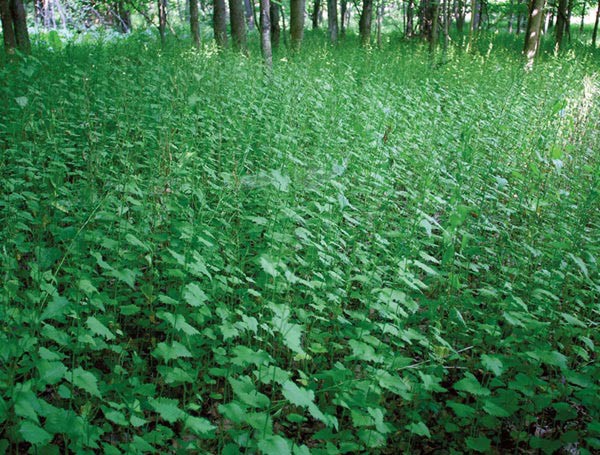
One of the most important relationships in the forest is between mycorrhizal fungi, a highly diverse group of soil microbes, and a wide variety of tree and understory plant species. The fungi attach themselves to plant roots and create a network of fungal filaments that extend the plant’s root system. The plants’ photosynthesis provides energy to the fungi, while the fungi help the plant take up nutrients in the soil.
But garlic mustard, an aggressive invasive plant from Eurasia that occupies disturbed areas in its home range, suppresses plant growth by disrupting this beneficial relationship. And the invader’s expansion into forested communities in North America has raised concerns about the effect it will have in local woodlands. A series of studies conducted at the Harvard Forest by ecologist Kristina Stinson and her colleagues detected a decline in plant abundance as garlic mustard populations increased.
Like other members of the mustard family, garlic mustard produces oils and other chemicals that repel insects and fungi. In controlled experiments, Stinson found that in the presence of garlic mustard, seedlings of sugar maple, red maple, and white ash had significantly fewer mycorrhizal fungi on their roots and grew one-tenth as fast. She also demonstrated that seedling growth and fungal colonization were reduced when garlic mustard extracts were added to the soil.
When Stinson tested the seedlings of 16 other native plants, only the hardwood trees and shrubs were harmed. She said that this is probably because it is more beneficial to the invasive species to harm the woody plants with which it would compete for space.
In additional tests, she removed garlic mustard from forested plots and found that the negative effects on the fungi and on the growth of sugar maple and white ash remained strong for as long as two years. She wrote in a research paper that “it appears that the ‘legacy’ of garlic mustard lasts long after its removal, apparently through the longevity of the exuded chemicals.”
Stinson also found that garlic mustard can be toxic to mushrooms and some bacteria that play an important role in decomposition, and other researchers have found evidence that it can be toxic to the caterpillars of some butterflies that feed on native plants in the mustard family.
In its native Eurasia, garlic mustard coexists with plants and soil organisms that are apparently resistant to its toxins. Stinson has found some evidence that microbial communities are evolving in North America that may be more resistant to its effects.
Effective management of garlic mustard invasions requires a long-term commitment because the seeds can remain viable in the soil for more than five years. Hand pulling or cutting the flowering stems at ground level to prevent seed production is preferred. Researchers are studying potential biological control agents that may prove effective against large-scale infestations.


Discussion *